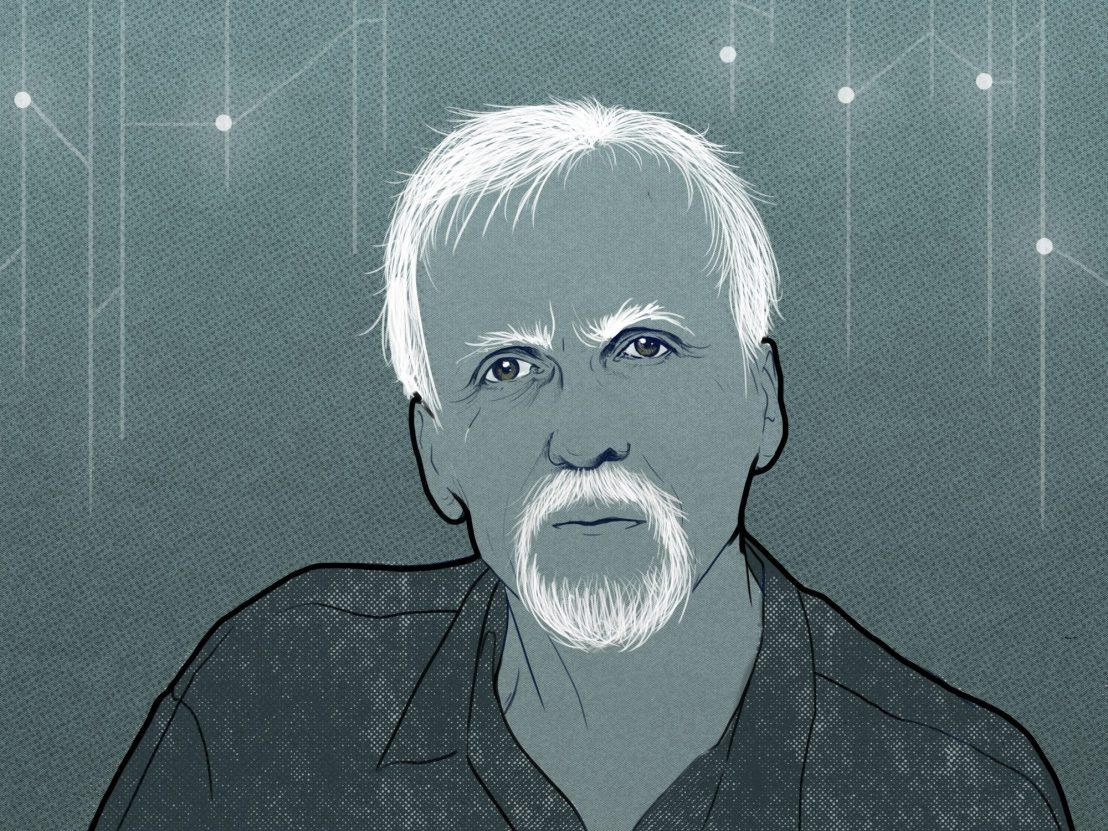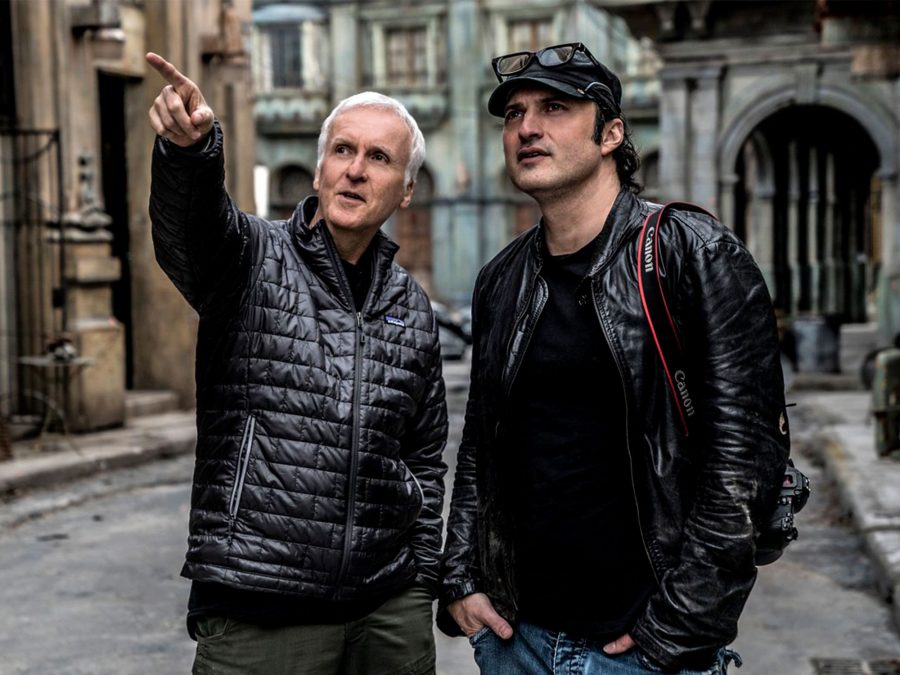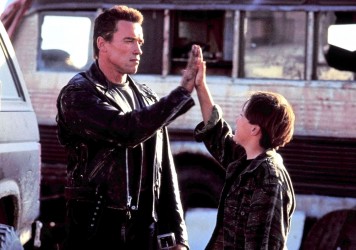
One of the most successful filmmakers of all time talks Alita: Battle Angel, Avatar and the future of cinema.
It’s easy to see how Yukito Kishiro’s early ’90s manga, Battle Angel Alita, would appeal James Cameron. It’s the story of a diminutive cyborg bounty hunter with a human brain, on a quest to meet her maker. Unlike the robot apocalypse of the Terminator films, this world posits an accord between humans and machines, though violence and suppression still reigns supreme. Cultural respite comes in the form of the high-speed, high-casualty death sport, Motorball.
After wrangling with the material for nearly 20 years, Cameron handed over his script to Robert Rodriguez who eventually directed Alita: Battle Angel, and become a creative producer on the project. LWLies met with Cameron ahead of the London premiere of Alita, and we discussed the evolution of the digital image, the death of analogue filmmaking and the stresses of having to dust his scale model of the Titanic.
LWLies: Alita: Battle Angel is powered by some extraordinary computer generated visuals. By what metric are you judging the success of these visuals?
Cameron: Robert and my producing partner John Landau were mostly responsible for the finished work on the visual effects in Alita. I’d cast my eye over things every week. I’d do a quick run-through of all the shots that were in progress. I’d give notes where I felt it was necessary. But it was really up to them.
What kind of notes were you giving?
For example, the Motorball stuff was struggling, because it was the most pure CG sequence in the film. Everything else was more set-based – there was no set for Motorball, other than the bleachers and the crowd. Everything on the track was 100 per cent computer generated. I thought it was not quite at the reality levels of the rest of the film. I suggested a few small changes that I thought would punch it up. They were embraced and executed, and I think it helped. Now I think the sequence is spectacular. I didn’t give any notes or movement or dynamics or editing or anything like that. Robert is masterful at all that. But some of the CG stuff he’s done in the past – and he’ll readily admit this – had a whimsical, slightly cartoony quality to it, like in the Spy Kids movies.
You get the sense he wasn’t aiming for photo reality in those films.
I agree. So I had to ask, how do you push it that extra little bit? I’d say 95 per cent of the review work was done by Robert and John Landau, to bring it home. John had been through that process on Avatar, so he knew it well. It wasn’t just me but it was my Lightstorm team, so that’s me and Richie Baynham overseeing all the Alita facial animation, and acting as an interface with the work being done by WETA. WETA, of course, are the best in the world at facial animation, especially the photo real stuff. But yeah, you have to be endlessly critical of visual effects to make sure they measure up. If they look good in isolation, I guarantee you they’re going to work in a flow. The eye is more forgiving in a flow than it is on a shot-by-shot basis. I thew in a few notes on lighting – punch up the edge a little more. It’ll make it gutsier.
It’s interesting to hear you talk about lighting with reference to digital effects.
There’s a tendency on the part of visual effects lighters to make everything look too perfect. The image is too well-filled, or well-modelled. You see everything. Real-world photography isn’t like that. There are parts of the frame you don’t see. They just go black and there’s nothing you can do about it. So I’m saying smash it with a strong light from this side, and let that other part go.
So it’s an attempt to emulate a more messy reality?
It’s critical to do that. The more CG there is in a scene – and I learned this on Avatar – the more the camera needs to be grounded in real-world physics and real-world optics. And that includes the flaws of real-world optics. Things like multi-element lens flares. You throw a multi-element lens flare across a scene where there’s a source light in the shot, all of a sudden it looks like it’s photography, even though it’s pure CG.
We played that game in Motorball as well. Though I can’t emphasise enough what a great collaboration this was. The Motorball sequence was storyboarded, pre-visualised, captured, shot-designed by Robert and edited by Robert, then executed by Lightstorm and WETA digital. So he had this really powerful machine on the back end to complete what he set in motion. I wasn’t in that process anywhere, only when shots were coming in close to final. I goosed them a little bit, over the edge to photo reality. I happen to know a lot of tricks.
I believe you.
Isn’t that how it should be? As a producer, you can be the guy that buys the rights, you can sit back and let people run with it and feel some false sense of authorship because you had a little bit of money at the right time and maybe some good taste. Or you could be the type of producer who puts together the financing and you’re just a bank. I don’t want to be either one of those. I want to be part of the team. I want to be there to serve, not to dictate.
Robert and I had a friendship of 25 years that preceded our work on this. We just agreed to be really respectful of each other’s territory. We each brought to it what we knew best. And Robert’s a shooter – he’s a floor guy. He loves to be out there with the camera and the crew. I never went to the set at all, that was his turf. Behind the scenes, we collaborated on the writing. I wrote the script and he cut it down. If he wanted to tweak some scenes, I’d throw some pages at him here or there. He’d rework them and send them back. We rewrote the ending a couple of times.
Did you ever feel he was trying to make a James Cameron film?
He sorta says he did that, but I don’t think that’s the truth of it. We served a common vision. I was channelling Yukito Kishiro and trying to bash all those books into something that would fit in a feature film. And then Robert was channelling me to some extent. But he doesn’t know where I would’ve put the camera. I would’ve directed this film differently. Any director would. Making a film is the artist’s personal creative moment. And that’s unavoidable. I can celebrate this film. If I go on the road with Avatar, I can’t say nice things about it. I can’t say I loved this movie. That’s a little cheeky. But I can say I loved this movie, as I didn’t direct it. I can feel a pride of authorship to an extent, but I can also celebrate it shamelessly.

In the film, Alita’s body is made from this antiquated technology that is still superior to technology being used in the present day.
This is the interesting thing about this story, and it’s innate in the manga – it’s the story of a future. It’s not the future, it’s the future of the future. She represents a technology that’s been lost for 300 years. It’s a mythic achievement in technology that people can’t seem to replicate.
Is there any reliable old technology that you use to make films now?
Interesting. There’s nothing we use now that I used when I started. Nothing. There’s photochemistry, which to me is obsolete. Mechanical movement is the same. As gorgeous as the Panaflex camera was – and it was a beautiful machine – it’s obsolete. Digital camera technology is so advanced now that I wouldn’t ever dream of going back to one of those old cameras. Large-scale physical miniatures, too, they’re gone. The last time I worked with miniatures was on Titanic. I still have the 42-foot long Titanic model, but it’s like a Model-T Ford. No, maybe something higher, like a Duesenberg or something.
The point is, we wouldn’t do it that way any more. We don’t work that way. We can’t. There’s too much flexibility with CG models. And they don’t degrade. I’m always repairing that damn Titanic. It’s always getting bumped into, railing getting snapped off, dust getting on the deck. We just do physical models, we don’t do matte paintings on glass, we don’t do photochemistry any more. And I think movies look better than they’ve ever looked. I know Chris Nolan disagrees, and he thinks that shooting on 65mm IMAX film is great, but you could achieve the same result digitally if you chose to.
How long before the camera is obsolete?
I don’t know if lenses and optics are ever going to be obsolete. If you can shoot something in the real world, by all means do so. I think it’s perverse to recreate reality, digitally, if you don’t have to. But on the other hand, by all means let your imagination roam freely and use CG where you need to. I think we’re gonna have lenses, we’re gonna have optics. We’re moving toward the live-action photography on Avatar, which we start shooting in May, and I’m choosing my lens package and doing my camera testing and so on.
I’m a firm believer in native 3D versus post-conversion. We have developed an incredible camera for Avatar 2 and 3. It’s based on their Cine-Alta cameras which will have 16 stops of dynamic range. It has 4 to 6K resolution. We’re putting two of them into a stereoscopic rig with nine axes of motion control, and 10-to-one zoom lenses. And the whole thing weighs 29lbs. I can put it on my shoulder easily. It’s mind-boggling.
It’s hard to get my head around what that would look like.
I asked the Sony guys, you know this little sensor plate you’ve got on your otherwise 25lb camera, how about you just took that off and gave it to me on the end of a cable? We spent two months negotiating how long the cable should be. We now have a means of having a light weight, nine-axis motion control rig that I can easily hand-hold. It’ll have a tether that’s about two-and-a-half metres long, that’ll run to a backpack. Or it’ll go to something nearby. But that rig is breathing in order to manipulate the stereo space. Sorry, I’m geeking out here.
Are we heading towards a future where computers will decide the shots for filmmakers?
I think you’ve got plenty of AI experts around who would say, yeah, sure. They’d take every movie every made, throw it into a massive database, feed all that into an AI, deep learning neural networks will analyse why they work, and you’ll have an AI create a movie – and it’ll suck. Because the AI is not embodied, it’s not having the human experience. It’ll be like a filmmaker who only knows other movies as opposed to being human.
People ask me all the time, ‘What would your advice be to a young filmmaker?’ It used to be, pick up a camera and start making a movie. Now my advice is, live a bit of life, then pick up a camera and make a film about what you know and what you’ve experienced. Don’t go from being a superfan in high school to film school, and come out knowing nothing about life except what you’ve seen in movies. Because you don’t know shit. You’ve got nothing new to say.
I stand by that now. That’s the journey I took. I left home when I was 18, I worked as a machinist, I worked as a school bus driver, a school bus mechanic, precision tool guy, truck driver, all kinds of stuff. Worked on auto body – what do you call it over here? I was a panel beater! Got married, had a house with a picket fence, and then I started making films when I was in my mid-twenties. I don’t think I missed anything. It’s not that I was late coming out the gate. I mean, Spielberg, he was 19 when he started, but he’s the exceptional case.
Your early short film Xenogenesis from 1978 is online and it’s still impressive.
It wasn’t a complete film, it was meant as a proof of concept reel to show that we could make a science fiction story.
The robotics element of that film is so great. You made these mechs which go into battle. Does the tactile art of robotics still have a place in modern filmmaking? Does physics matter any more?
You don’t have to make a thing any more. I mean, 85 per cent of the new Avatar films is CG. But we don’t use robotics, we use people. It’s important to not uncouple the final image from hard physics. I’ve shot a lot of photography in the real world, I’ve operated all the different types of camera myself. I think the more you embrace CG, the more you need to be mindful of what the image would’ve really looked like had you shot it with a camera and physical objects. Because then it becomes just an animated film. And I don’t mean just an animated film – it becomes an animated film uncoupled from reality. If you’re trying to convince an audience that what they’re seeing is real, then you have to know. I’m a little concerned that a lot of CG artists only come up via the CG world. They’re not out there making images the hard way – with light. We’re very cognisant of that on the Avatar films.
The intersection between live-action and animation seems so thin now. There’s a new Lion King movie which is being referred to as live action.
Performance capture is not live action. It’s not key-frame animation. It’s human performed, but it doesn’t use optics at all. I live with this every day on the Avatar films. How do you create the illusion of photo reality? Which is really what we’re talking about. It has to be a compelling illusion.
That aim feels very human.
Sure, and when I say I that, what I mean is you have to embrace flaws. What happens when the camera gets hit by something, or some mud or water gets on the lens? The more you can create the illusion that there was a physical camera there, the audience, which has been conditioned by 100 plus years of photography, is going to believe the image that they see. Cinema is all about that belief.
Alita: Battle Angel is in cinemas 6 February. Read the LWLies Recommends review.
Published 6 Feb 2019
By Matt Thrift
The true greatness of James Cameron’s record-breaking space opera is not in its conception but its execution.

Robert Rodriguez’s latest is that rare beast: a throwback, effects-driven science fiction epic that runs on an infectious sense of fun.

By Taylor Burns
James Cameron’s original and best Terminator sequel has always existed on its own spectacular terms.